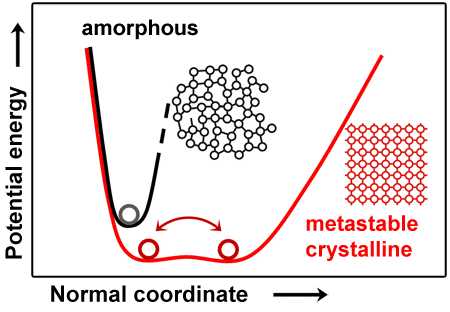- Home
- News
- General News
- Low thermal conductivity...
Low thermal conductivity of phase-change materials explained through synchrotron studies
17-05-2011
Low thermal conductivity is a key feature of phase-change materials and is important for their application in fast, non-volatile memory. Studies at the ESRF have provided an explanation of this unusual feature. This knowledge will help in the design of materials with optimal properties for future electronic components.
Share
Phase-change materials are widely used for optical data storage such as rewritable CDs and DVDs. A laser is used to thermally transform regions of the material from an amorphous to a crystalline state. The difference in optical reflectivity between the two states permits the stored data to be read with a laser. Phase-change materials also have a significant difference in electronic resistivity between the amorphous and crystalline phases. Such materials are promising candidates for future fast, non-volatile memory in which the amorphous to crystalline transformation would be triggered by heating via electrical pulses. The state of the active material can then be probed by applying low voltage pulses to determine the electric resistance. Low thermal conductivity is a prerequisite for energy efficient memory devices, to minimise the power and pulse duration for switching operations (converting from crystalline to amorphous), and to permit higher data density through heat transmission to the smallest area possible.
The amorphous and crystalline states have significant differences in optical reflectivity, which is explained by the bonding within the phases; saturated covalent bonds in the amorphous phase, and additional stabilisation in the crystalline phase from a phenomenon called resonance bonding, i.e. a superposition of configurations with saturated covalent bonds. However, a surprising feature of some phase-change materials such as GeTe-Sb2Te3-alloys is the low thermal conductivity of both phases. This feature has remained without explanation until now.
A team of researchers from Japan and Europe have examined the thermal and electrical conductivity of phase change materials through synchrotron studies. Their results permit an insight into the origin of the unusual thermal properties of these materials and have just been published in the journal Advanced Functional Materials.
European authors of the paper include Dr. Raphaël Hermann from the Jülich Centre for Neutron Science (Germany) and Prof. Matthias Wuttig from RWTH Aachen University (Germany). Hermann and Wuttig investigate the origin of the surprisingly low thermal conductivity of Ge-Sb-Te alloys. They carried out nuclear inelastic scattering experiments at beamline ID22N. Their results demonstrate that the bonding conditions between the atoms in the crystalline state as well as deviations from the perfect lattice structure influence the transmission of vibrations through the material and thus reduce its thermal conductivity.
"The starting point for our investigations was the observation by our Japanese colleagues that the amorphous material seemed harder than the crystalline for optical phonon modes", says Hermann. "This contradicted all assumptions, but the measured stronger bonding forces between the atoms in the amorphous state fitted the picture." The Jülich scientists investigated how the atoms in the specimens vibrate – both locally in the atomic range and also over longer distances. "In the crystalline material, we found harder vibrations for the long-range order and better conductivity for sound than in amorphous material. This is normal and is related to an increase in the order. However, we were surprised by the results for short-range vibrations in the crystal. They were softer. The short-range order in crystalline material is therefore lower than in amorphous material. This is very unusual."
On the basis of all the experimental results, the Aachen research group headed by Wuttig developed a model to explain the apparent contradictions (see figure below). The softening of optical phonon modes upon crystallisation implies that interaction potentials become softer as well. The structural analysis by their Japanese colleagues revealed increased bond lengths upon crystallisation (The softer potentials and the longer bonds are depicted in the figure). The structural data further indicate a larger anharmonicity than in the amorphous phase with a less symmetric interaction potential. This anharmonicity has profound effects on thermal conductivity, as it increases collisions between the heat carrying phonons and therefore reduces the distance over which these phonons can transport thermal energy.
 |
|
Schematic interaction potential for the amorphous and the crystalline state of a characteristic phase-change material such as Ge2Sb2Te5 can be explained with an interaction potential diagram. The interaction potential for certain normal co-ordinates in the amorphous phase is more harmonic (symmetric), which results in smaller thermal expansion. The interaction potential of the metastable crystalline phase is weaker and more anharmonic, which leads to significant thermal expansion. The combination of resonance bonding and static distortions leads to this interaction potential, which explains a number of characteristic properties such as the pronounced anharmonicity and the soft phonon modes. Image credit: Jülich Aachen Research Alliance – JARA. |
"Normally, the propagation of sound waves in material correlates with the thermal conductivity. However, this is not the case with phase change materials. This is due to the fact that in the crystalline state atoms experience resonance bonding – in other words, the bonding electrons are shared between several atomic pairs. In contrast, in amorphous material the atoms are covalently bonded. This means that bonds are harder and more strongly localised. The crystalline material is therefore softer and the atoms vibrate more gently. In addition, there is more disorder in the local range. Both of these aspects impair the conductivity for heat carriers, which are partially of short wavelength, but not for the long-wavelength sound waves."
The knowledge gained in this research will facilitate the systematic selection of better materials for future non-volatile memory, since the thermal conductivity of the crystalline phase is required to be low and therefore materials with strong anharmonicity need to be chosen.
Reference
Phase change materials: Vibrational softening upon crystallization and its impact on thermal properties; Matsunaga et al., Advanced Functional Materials; DOI: 10.1002/adfm.201002274.
Top image: Phase-change materials are widely used for optical data storage and have potential for future non-volatile memory.



